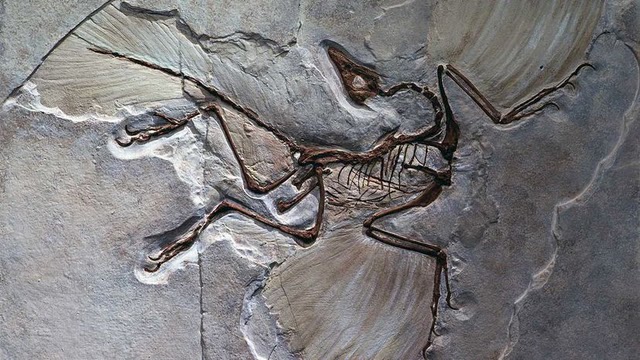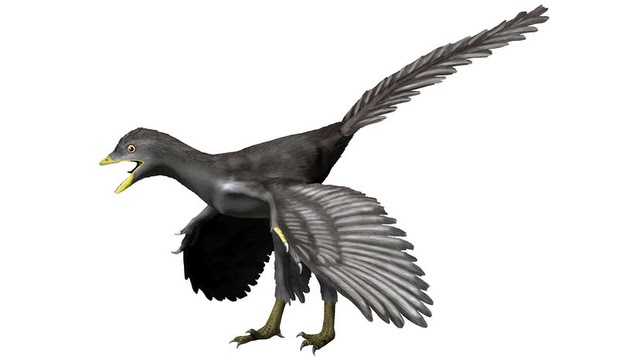Quck answer
Archaeopteryx is a bird-like dinosaur that lived during the Jurassic period, around 150 million years ago. It had feathers, wings, and teeth, making it a transitional fossil between dinosaurs and birds. It was about the size of a crow and likely used its wings to glide or fly short distances. Its teeth suggest that it ate small prey like insects, worms, and lizards. Archaeopteryx is an important discovery in the field of evolutionary biology, providing evidence for the theory of evolution and the link between dinosaurs and modern birds.
Extinct Animals

Archaeopteryx was a birdlike dinosaur that lived during the Jurassic Period and likely required a running start to take flight. The German paleontologist Christian Erich Hermann von Meyer first described this animal in 1861 after discovering a fossil feather in a limestone quarry near Solnhofen, Bavaria. The name Archaeopteryx lithographica aptly means “ancient wing.” This discovery coincided with Charles Darwin’s publication of “On the Origin of Species,” and Archaeopteryx quickly became part of the conversation about evolution and natural selection.
Additional fossils emerged, including a birdlike creature with a bony tail that modern birds lack. The “London specimen” was purchased on behalf of the Natural History Museum in London, while the more well-known “Berlin specimen” is showcased at the Natural History Museum of Berlin and has a complete skull with small teeth. Unlike modern birds, Archaeopteryx had three clawed fingers on each hand. Around 12 individual Archaeopteryx remains have been found in Bavaria’s Jurassic rock deposits, which are approximately 150 million years old. There is a debate about whether the skeletal fossils and von Meyer’s original feather belong to the same animal, with conflicting conclusions from studies published in the journal Nature in 2019 and 2020.

This fossil casting is from the “Berlin specimen,” an Archaeopteryx found at the Blumenberg quarry near EichstГ¤tt, Germany, in 1877. It’s now displayed in the Natural History Museum of Berlin.
James L. Amos/Getty Images
Leaving the Nest
Archaeopteryx belonged to a group of dinosaurs called theropods, which includes Tyrannosaurus rex, Velociraptor, and all birds that have ever existed. The second toe on each foot was hyperextensible, allowing Archaeopteryx to hold the digits upright even when standing to prevent the claws from wearing down too quickly. Some believe that a different set of toes may have been somewhat opposable, potentially allowing Archaeopteryx to grasp things with its feet. Fossils suggest that Archaeopteryx grew to be around 21 inches (53 centimeters) long with a 2-foot (60-centimeter) wingspan, but this might not represent the maximum size. According to a 2009 bone structure study, Archaeopteryx reached maturity at a slower rate than most living birds and would have weighed approximately 1.8 to 2.2 pounds (822 to 1,009 grams) as mature adults, similar in size to common ravens.
Prehistoric Feathers
In 1861, a feather was discovered by von Meyer that is believed to be a covert feather, meaning it covered the bases of larger feathers. Some feathers found in deposits with Archaeopteryx, including von Meyer’s feather, were either completely or partially black due to microscopic pigment structures. Black feathers can provide an advantage as the pigment responsible for the color strengthens flight feathers. Ravens also use their dark feathers to regulate body temperature by absorbing heat from the sun, which can then be dissipated by passing winds.
Feathers serve multiple purposes for birds, including regulating body temperature and attracting mates. Like modern birds, Archaeopteryx had feathers that varied in size and shape across different regions of its body. One specimen has the imprints of asymmetrical tail feathers measuring 3.9 to 4.5 inches (9.9 to 11.4 centimeters) and smaller, symmetrical leg feathers that are 1.5 to 1.7 inches (4 to 4.5 centimeters) long. This dinosaur may have looked like it was wearing shaggy trousers.

Microscopic pigment structures left behind show that the Archaeopteryx had either partially or completely black feathers.
Dinosaur Island(s)
Archaeopteryx is thought to have lived in Bavaria during a time when the area was a subtropical archipelago full of lagoons and barrier islands. The fossils are well-preserved due to the south German limestones being a “lagerstatten.” Unrelated flying reptiles called pterosaurs appear in the same lagerstatten, along with the bones of Compsognathus, a small theropod. Fossilized beetles, dragonflies, jellyfish, fish, crustaceans, and swimming reptiles have also been found. Scientists think Archaeopteryx ate smaller animals like insects.
Artists often depict Archaeopteryx perched on elevated tree branches. However, during its time, low-lying shrubs were probably more common than trees. The “trees-down” hypothesis proposes that the direct ancestors of the first flighted birds were tree-climbers who would glide from branch to branch.
Limitless Sky?
Archaeopteryx’s flying capabilities are still debated, but many scientists believe it was a half-decent flyer. In 2018, a team of researchers examined the wing bones of three different Archaeopteryx and compared their proportions with the arms of 69 different animals, from extant birds to nonavian dinosaurs. Based on the bones, the team concluded that Archaeopteryx could probably fly for short bursts, similar to modern pheasants and turkeys. However, the dinosaur’s shoulder anatomy would have made it incapable of flapping its wings like modern birds. Other research suggests that Archaeopteryx took off from ground level but may have needed a running start.
Experts disagree on how to classify Archaeopteryx. Some consider it a basal bird, while others believe it had more in common with Velociraptor and its relatives. All birds are theropods, but not all theropods were birds.
The discovery of dinosaurs with feathers and similar body coverings that predate Archaeopteryx by millions of years is constantly occurring at dig sites worldwide. Moreover, recent findings of tiny theropods with “bat-like” wings indicate that the evolution of flight in dinosaurs was a complicated process. Although Archaeopteryx initiated this discussion, the future of this topic is unpredictable. Interestingly, the full scientific name of Archaeopteryx is Archaeopteryx lithographica, referencing one of Bavaria’s geological industries where limestone slabs were collected for construction purposes or to create lithographs.
FAQ
1. What is Archaeopteryx?
Archaeopteryx is a prehistoric bird-like dinosaur that lived approximately 150 million years ago. It is considered a transitional fossil between dinosaurs and modern birds.
2. What makes Archaeopteryx unique?
Archaeopteryx is unique because it had both feathers and teeth, which is not seen in modern birds. It also had a long bony tail, claws on its wings, and a dinosaur-like skull.
3. Where was the first Archaeopteryx fossil found?
The first Archaeopteryx fossil was found in 1861 in a limestone quarry in Germany.
4. How many species of Archaeopteryx are there?
There is only one species of Archaeopteryx: Archaeopteryx lithographica.
5. How big was Archaeopteryx?
Archaeopteryx was about the size of a crow, with a wingspan of approximately one meter.
6. Was Archaeopteryx able to fly?
It is believed that Archaeopteryx was able to fly, but it may not have been a strong or efficient flier. Its feathers may have been used more for gliding than for powered flight.
7. What did Archaeopteryx eat?
Archaeopteryx likely ate insects and small animals, such as lizards and mammals.
8. What is the significance of Archaeopteryx?
Archaeopteryx provides evidence for the evolution of birds from dinosaurs. Its combination of bird-like and dinosaur-like characteristics helps to bridge the gap between these two groups of animals.
9. Are there any living descendants of Archaeopteryx?
No, there are no living descendants of Archaeopteryx. However, all modern birds are descended from a common ancestor that lived around the same time as Archaeopteryx.
10. Where can I see an Archaeopteryx fossil?
There are only 12 known Archaeopteryx fossils in existence, which are all housed in museums in Germany. The most famous specimen, known as the Berlin specimen, is on display at the Museum fГјr Naturkunde in Berlin.





Leave a Reply